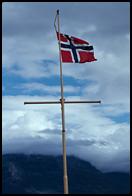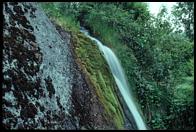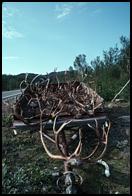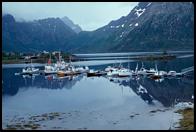

|
Notes from Trondheim, Norway |
This is the first of four emails that I sent to various friends when I found Internet access during my trip. You can read it, or skip to one of the other three:
You can also download the original ASCII email archive, probably more suitable for printing.
Tired of the talk, and burning to be on the road tomorrow? You may be
interested in my notes on equipment.
Sticky New England summers got you down? Tired of the monotony of endless California sunshine? Do I have a country for you! Norway, land of Vikings, polar bears (though admittedly to see those you have to go to the Svalbard Islands, about 700km north of the northernmost mainland tip where I started my trip), and cyclists with cold, cold extremities.
 In fact, I should say right away that, even after 9 winters cycling in Boston
and despite the most careful equipment preparations, Norway has defeated me.
The original plan was to cycle about 1600km from North Cape south to
Trondheim, where Rosalba will arrive tomorrow to join me on the second leg
of the trip, 40 days across southern Norway and central Europe to Prague in
the Czech Republic. However, on Friday, drenched by days of freezing rain
and buffeted by winds that sometimes reduced my maximum speed to 6 or 7km/h,
I gave up cycling about 350km north of Trondheim, and took the train the
rest of the way down here. This was a great decision, but rather alarming
in some ways: a subtle indication that I might just be growing older
or---perish the thought!---more mature. Just a couple of years ago I would
have clenched my teeth, ignored my burning throat and numb feet, and cycled
on through the storm. But on Friday I realized that my wannabe-macho
self-image just wasn't worth three days of miserable suffering, and that I
could have a better time by taking the train for a bit and spending three
days in a pretty pleasant university town. It was quite a discovery, and
now my throat is less sore, too.
In fact, I should say right away that, even after 9 winters cycling in Boston
and despite the most careful equipment preparations, Norway has defeated me.
The original plan was to cycle about 1600km from North Cape south to
Trondheim, where Rosalba will arrive tomorrow to join me on the second leg
of the trip, 40 days across southern Norway and central Europe to Prague in
the Czech Republic. However, on Friday, drenched by days of freezing rain
and buffeted by winds that sometimes reduced my maximum speed to 6 or 7km/h,
I gave up cycling about 350km north of Trondheim, and took the train the
rest of the way down here. This was a great decision, but rather alarming
in some ways: a subtle indication that I might just be growing older
or---perish the thought!---more mature. Just a couple of years ago I would
have clenched my teeth, ignored my burning throat and numb feet, and cycled
on through the storm. But on Friday I realized that my wannabe-macho
self-image just wasn't worth three days of miserable suffering, and that I
could have a better time by taking the train for a bit and spending three
days in a pretty pleasant university town. It was quite a discovery, and
now my throat is less sore, too.
The first thing you notice about northern Norway is how much water there is. I have never been in any other place with more water. There's water in the fjords, water coming down from the sky, water collecting in huge lakes and swamps that stretch across endless thawing sub-arctic plains, water rushing by (and sometimes over) the road in noisy torrents, water seeping up through soggy sod in semi-flooded campsites. Fortunately wool keeps you (relatively) warm even when it's wet. I like wool.
 The first thing you notice about Norwegian people is how proud they are of
their water. I'd stop at a gas station, point to a water fountain next to
the gas pump, and enunciate clearly (I am rather embarrassed by my complete
inability to speak Norwegian): "Drinkable? Trinkwasser?" The answer was
never "no," but it was rarely a simple "yes": usually I would receive a look
of bemused bewilderment, or even gentle condescension, as if to say, "What
planet are you from? In my country even the drain water in urinals is
drinkable!" I met a cyclist in northern Finnmark who told me that he'd
stopped at a farmhouse to ask for water, and the farmer had simply given his
bottles back to him empty and pointed him to a stream by the side of the
road...
The first thing you notice about Norwegian people is how proud they are of
their water. I'd stop at a gas station, point to a water fountain next to
the gas pump, and enunciate clearly (I am rather embarrassed by my complete
inability to speak Norwegian): "Drinkable? Trinkwasser?" The answer was
never "no," but it was rarely a simple "yes": usually I would receive a look
of bemused bewilderment, or even gentle condescension, as if to say, "What
planet are you from? In my country even the drain water in urinals is
drinkable!" I met a cyclist in northern Finnmark who told me that he'd
stopped at a farmhouse to ask for water, and the farmer had simply given his
bottles back to him empty and pointed him to a stream by the side of the
road...
The second thing you notice about northern Scandinavia is the sheer size and emptiness of the place. Prior to this trip, west Texas and eastern New Mexico had held the top spot in my list of barren wastelands. Of course, my perspective may be biased, because I traveled down there in a car in the company of my father, whereas here I was alone on a bike. However, I have never felt more isolated and in the middle of absolutely nowhere than I did in the first few days in northern Finnmark. At least in the southwest after a few hundred miles you can reach a relatively big city like San Antonio or Santa Fe. But up here, you can go for almost 1000km in any direction and never reach a settlement of more than a couple tens of thousands. Most towns have just a few hundred people living in houses along the only road. One particularly barren day featured almost 100km of almost nothing---no trees or vegetation other than scrub-like grass and wildflowers, no roads other than the one "Arctic Highway", and no houses, rest stops, or habitation of any kind except for a couple of tepees set up by the Sami, the nomad reindeer herdsmen who bring their herds north during the summer. Just a road, some power lines, lots of rivers and lakes, mosquitoes, a few Sami, and one large herd of reindeer. Once in a while a black speck would appear on the horizon in front of me and grow slowly bigger, occasionally disappearing in the dips in the road. It would grow to the size of a huge double-decker bus taking German and Scandinavian tourists to North Cape, rush by me in a stinging cloud of fumes and road grit, and then everything would be quiet again.
 Most Sami settlements are squalid and sad, uncannily reminiscent of some
Indian reservations I've seen in the southwest. Apparently the similarities
are more than just superficial. From what I understand, the Sami were the
native people in Scandinavia north of the Arctic Circle; for a few centuries
they were pushed back and forth as Norway, Sweden, Finland, and Russia
squabbled over borders, and then in the early part of this century they were
subject to various forms of "cultural homogenization"---forbidden to speak
their language, forcibly encouraged to enter mainstream Norwegian life, and
so forth. Not quite as bad as what happened to most American Indians, but
not exactly great. Today things are better---the language is no longer
banned, for instance---but the Sami I saw were reduced to roadside peddlers
of reindeer antlers, ethnic costumes, and other stuff aimed for tourist bus
consumption. Ultramodern buses stop and disgorge waves of rowdy and obese
visitors while half-naked Sami children run around the battered pick-up
truck and assorted rusty metallic refuse in the back of the encampment.
It's depressing, and it doesn't smell very good. A couple of times I was
tempted to stop and take a picture of the huge, surreal collections of
antlers laid out by the side of the road, but I was always too embarrassed.
Most Sami settlements are squalid and sad, uncannily reminiscent of some
Indian reservations I've seen in the southwest. Apparently the similarities
are more than just superficial. From what I understand, the Sami were the
native people in Scandinavia north of the Arctic Circle; for a few centuries
they were pushed back and forth as Norway, Sweden, Finland, and Russia
squabbled over borders, and then in the early part of this century they were
subject to various forms of "cultural homogenization"---forbidden to speak
their language, forcibly encouraged to enter mainstream Norwegian life, and
so forth. Not quite as bad as what happened to most American Indians, but
not exactly great. Today things are better---the language is no longer
banned, for instance---but the Sami I saw were reduced to roadside peddlers
of reindeer antlers, ethnic costumes, and other stuff aimed for tourist bus
consumption. Ultramodern buses stop and disgorge waves of rowdy and obese
visitors while half-naked Sami children run around the battered pick-up
truck and assorted rusty metallic refuse in the back of the encampment.
It's depressing, and it doesn't smell very good. A couple of times I was
tempted to stop and take a picture of the huge, surreal collections of
antlers laid out by the side of the road, but I was always too embarrassed.
Another odd thing in Norway is the gambling. Every public place---grocery store, supermarket, gas station, train station, ferry landing, you name it---has slot machines. It's pretty common to see a tough, wizened old man who looks like he's spent his life on a cod fishing boat drop Kr50 (about $7) into one of these machines, spend the next few minutes spinning wheels and pushing buttons to the flash of lights and the beat of Abba-style Scandinavian disco, and then leave emptyhanded with hardly a word or a shake of the head. Little kids love gambling too. The contrast between the rural outdoors, the relative poverty of the people, and the Vegas-like gleam and sound of the gaming machines is rather strange.
 About four days of cycling and 600km south of North Cape the scenery becomes
more normal and predictable: snow-capped mountains, pretty coastline, small
farms nestled in the thin strip of greenery between the ocean and the rocky
mountainsides. The trees, initially small and stunted, gradually take on a
more normal appearance. If you're ever in Norway, make sure to go to the
Lofoten Islands. A little out of the way, but there's not much traffic and
the scenery is splendid: they're a small gem that encases the best of what
I've seen of Norwegian scenery so far. Unfortunately, south of the
northernmost areas I only had a couple days of sunshine; after that, a week
of rain and wind, with temperatures often in the high 30s (4-5 deg Celsius).
150km a day with frozen feet is not the greatest thing. By the time I
took the train to Trondheim I had no dry clothes and the tent was soaked
too.
About four days of cycling and 600km south of North Cape the scenery becomes
more normal and predictable: snow-capped mountains, pretty coastline, small
farms nestled in the thin strip of greenery between the ocean and the rocky
mountainsides. The trees, initially small and stunted, gradually take on a
more normal appearance. If you're ever in Norway, make sure to go to the
Lofoten Islands. A little out of the way, but there's not much traffic and
the scenery is splendid: they're a small gem that encases the best of what
I've seen of Norwegian scenery so far. Unfortunately, south of the
northernmost areas I only had a couple days of sunshine; after that, a week
of rain and wind, with temperatures often in the high 30s (4-5 deg Celsius).
150km a day with frozen feet is not the greatest thing. By the time I
took the train to Trondheim I had no dry clothes and the tent was soaked
too.
A warm room and a dry bed are pretty good stuff after a week like the last.
To limit expenses I'm staying in a sort of student-run university youth
hostel. 15-20 beds to a room and a cool coffeehouse downstairs---from which
I'm writing this mail---that feels a little like MIT's 24-hour coffeehouse
in the student center. Unfortunately, though, there are a few too many
19-year-olds with punk hairdos and Metallica T-shirts who look like they've
run away from home; it feels like a time warp back to high school or
something. Life is strange: a couple days of silly teenage metalheads and
you start to miss the mosquitoes of Finnmark.
Go on to Notes from Copenhagen, Denmark.
| Top |